Choosing the Right Glue for Stone Projects
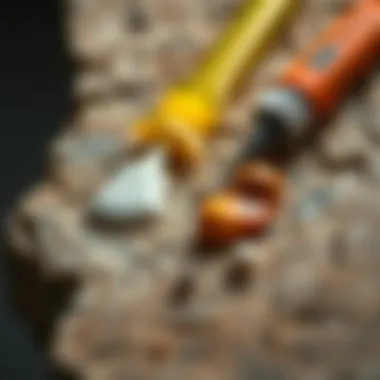
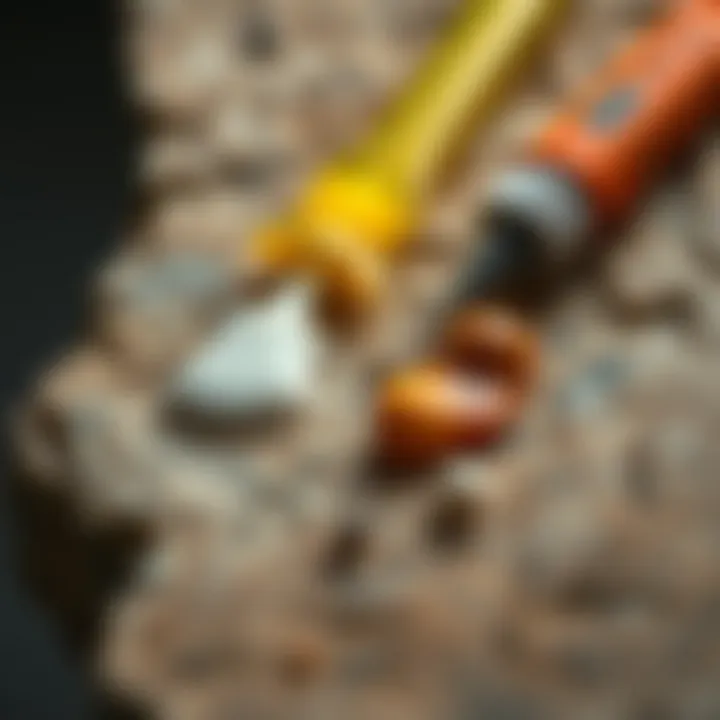
Intro
When it comes to working with stone, whether it’s to repair a cherished fossil or to craft an artistic sculpture, selecting the right adhesive can be the difference between a job well done and one that crumbles under pressure. The world of glue for stone is not just about sticking two pieces together; it involves understanding the properties of various adhesives and their applications suited specifically for stone materials. This guide aims to peel back the layers of complexities surrounding stone adhesives, offering insights into their selection and usage, ensuring both novice and experienced individuals can approach their projects with confidence.
Stone is an ancient medium, cherished for its durability and aesthetic appeal, and humans have been utilizing it in various forms for thousands of years. Just as different stones possess unique characteristics, so too do the glues designed to bond them. In this article, we’ll explore the historical context, types of adhesives available for stone, and give practical advice for their application, ensuring the enduring nature of your stone projects.
History and Origins
Overview of Stone Use in Collectibles and Art
Throughout history, stone has held a prominent place in craftsmanship and art. From the Paleolithic carvings to modern sculptures, humanity's relationship with stone is as solid as the material itself. Artifacts and collectibles made from stone often carry significant cultural and historical weight.
In ancient Egypt, artisans utilized stone adhesive techniques to assemble massive pieces of sculpture and architecture. We see similar practices in the Roman Empire, where gluing techniques were key in constructing durable building facades. As time progressed, different types of stone and their adhesives evolved, leading to today’s variety of specially formulated glues.
Historical Significance and Cultural Impact
The use of adhesives for stone goes back centuries, but it wasn't until the 20th century that many modern formulations began emerging. As collectors and restorers sought ways to preserve or enhance their stone items, the demand for specific adhesives tailored for various types stone grew.
This interest in stone and its bonding agents speaks to a broader cultural appreciation for history and preservation. For collectors, the right adhesive isn't just about functionality; it’s about respecting the integrity and story behind each piece. A simple misstep in adhesive selection can tarnish years of history.
"The choice of adhesive reflects more than utility; it’s a commitment to honoring the past while ensuring the future stability of these stones."
Identification and Classification
Guide to Identifying Stone Types
Before selecting an adhesive, it's paramount to identify the type of stone you’re working with, as this will greatly influence your adhesive choice. Here are some common stone types you might encounter:
- Granite: Known for its durability and resistance to weathering; often used in monuments.
- Marble: A softer stone, prized for its beauty but more vulnerable to certain adhesives.
- Limestone: Porous and requires careful adhesive formulation to avoid damage.
- Slate: Thin layers make it unique, but the layering can complicate bonding.
Common Variations and Their Adhesive Needs
Each stone’s characteristics influence how it interacts with adhesives. For instance:
- Porosity: A porous stone needs an adhesive that can seep into and fill voids, where a non-porous, dense stone might require a surface-based adhesive for optimal bonding.
- Color: A clear adhesive might be essential for maintaining the visual aesthetics of stones, particularly in art pieces.
Understanding these nuances ensures that whether you’re restoring a geological specimen or crafting an art piece, you choose a glue that complements the properties of your materials.
With this foundational knowledge, you're well on your way to making educated choices regarding the adhesives that best suit your stone projects. Moving forward, we will dive deeper into each type's specific formulations and practical applications, highlighting what distinguishes them in functionality and context.
Prelude to Adhesives for Stone
When it comes to working with stone, whether for restoration, artistic creation, or structural repairs, adhesives play an essential role. Understanding the nuances of glue designed specifically for stone is crucial for successful application and long-term durability of joined materials. Stone is often revered for its aesthetic appeal and durability, but without the right adhesive, even the finest stone can become compromised. What this segment aims to provide is a solid foundation on the various aspects of adhesives tailored for stone.
Defining Glue for Stone
So, what exactly is glue for stone? Simply put, it refers to specialized adhesives formulated to bond stone materials effectively. Unlike standard glues, these adhesives take into account the unique properties of stone. Each type of stone—whether it's granite, marble, or limestone—has different textures, porosities, and chemical compositions. For instance, epoxy resins provide a strong, durable bond, while silicone adhesives offer flexibility and resistance to weather elements. Selecting an appropriate adhesive requires understanding the material properties that dictate how well different glues will adhere to stone surfaces.
Importance in Restoration and Crafting
The significance of using the right glue in restoration and crafting cannot be overstated. In the realm of stone restoration, using improper adhesives can lead to disinformation about the original structure, potentially causing damage. For example, using a glue that expands or contracts with temperature extremes could crack the stone or diminish its structural integrity over time.
Furthermore, in artistic applications, the choice of adhesive can affect not just durability but also the aesthetic outcome. A clear-drying glue, for example, might be ideal for projects where visibility is a concern, preserving the natural beauty of the stone.
"A craftsman is only as good as the tools he uses; the same goes for the materials, especially adhesives."
Finally, understanding the relevance of adhesives in conjunction with specific project requirements ensures that collectors and artisans alike can create functional and visually pleasing results. By making informed choices about stone adhesives, one can elevate a simple project into a work of lasting artistry.
Types of Glue for Stone
Understanding the different types of adhesives for stone is crucial for any rock and fossil collector or restoration artist. Each type of glue is uniquely formulated to bond stone effectively while considering specific project needs. When selecting an adhesive, the choice not only impacts the longevity of the bond but also the integrity of the stone itself. Knowing the strengths and weaknesses of each adhesive can guide you in making informed decisions, ensuring successful projects every time.
Epoxy Adhesives
Epoxy adhesives are renowned for their robustness and versatility. Composed of a resin and a hardener, these adhesives create an incredibly strong bond when properly mixed and cured. For stone applications, epoxy is often favored because it can bond dissimilar materials and withstand significant stress.
- Benefits: One of the standout properties of epoxy is its excellent water resistance. When used on stone, it prevents moisture infiltration, which can lead to deterioration over time. Additionally, it fills gaps and cracks, making it ideal for restoration projects where surface imperfections are common.
- Use Cases: Artisans often use epoxy in crafting sculptures or in the repair of broken stone pieces. Given its resistance to thermal expansion, it is also suitable for structural applications in varying climates.
"When working with stone, choose an adhesive that not only bonds but also protects."
Despite its advantages, epoxy also has drawbacks. It can be challenging to apply due to its thick consistency, and achieving the right cure time requires precision. Moreover, once set, it is notably difficult to undo mistakes, demanding that each application be approached with caution.
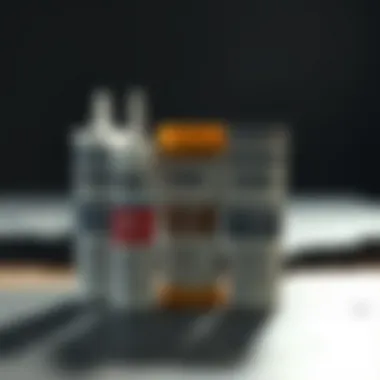
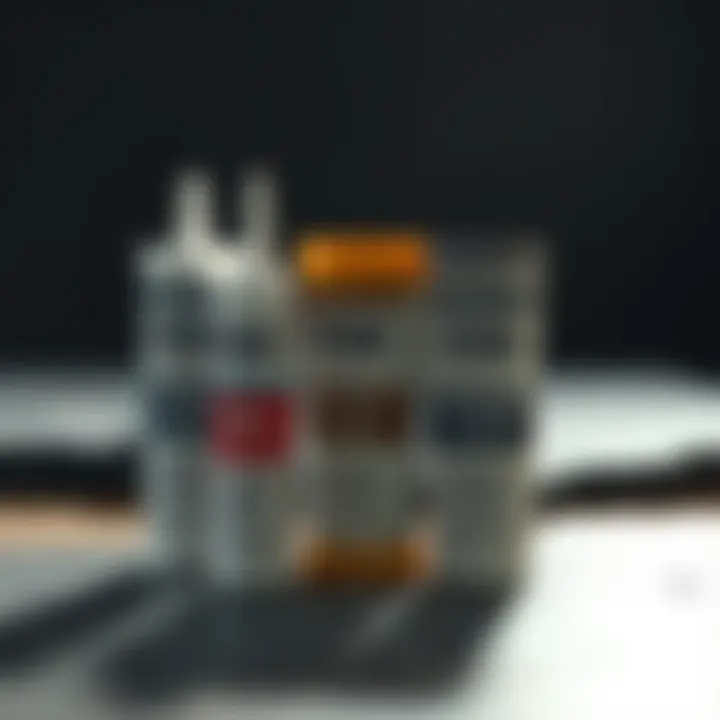
Polyurethane Adhesives
Polyurethane adhesives are another popular option for bonding stone. They are known for their flexibility and strength, making them suitable for various applications. Unlike rigid adhesives, polyurethanes can tolerate movement and expansion—characteristics often required in stone installations.
- Benefits: This type of adhesive is particularly advantageous in outdoor settings, as it is resistant to moisture and UV light. These properties prevent degradation over time, allowing it to hold up even under harsh environmental conditions.
- Use Cases: They are widely used in landscaping and construction for bonding stone pavers or tiles, providing a reliable and durable bond.
While polyurethane adhesives are user-friendly, they can expand during curing. This expansion must be monitored to avoid any overflow or unwanted adhesion on adjacent surfaces, which might complicate the repair work.
Cyanocrylate Adhesives
Cyanocrylate adhesives, often referred to as ‘super glue,’ offer incredibly fast bonding times. These adhesives cure quickly upon exposure to moisture, making them a go-to for smaller, quick repairs. However, they are not always the best choice for larger stone projects where strength is paramount.
- Benefits: Their quick-dry feature is ideal for quick fixes, providing initial hold almost instantly. They bond well with porous surfaces, making them suitable for lighter stone pieces or ornamentation.
- Use Cases: Particularly for art installations where broken pieces are reattached, or in situations that require minimal downtime, cyanocrylate can be invaluable.
The downside of cyanocrylate is its limited gap-filling capability and weaker long-term bond compared to epoxies and polyurethanes, which could lead to potential issues if not carefully considered.
Silicone Adhesives
Silicone adhesives present yet another alternative for stone bonding, preferred mainly for their flexibility and weather resistance. Commonly used as sealants, they create a durable bond that can accommodate movement without cracking.
- Benefits: Silicone adhesives are great for outdoor environments since they resist UV damage and moisture. Plus, they can maintain their elasticity over time, making them ideal for settings where temperature fluctuations could cause expansion and contraction of materials.
- Use Cases: Often found in masonry or sealing stone countertops, silicone can provide a waterproof barrier while ensuring a long-lasting bond.
However, it’s essential to note that while silicone is excellent for protecting joints, it does not provide the same strength as other adhesives and should not be used where a hard bond is required.
Selecting the right type of glue is imperative for any stone project. Balancing the unique properties and requirements of your application will ensure the best outcome and longevity of the bond. By understanding these four types of adhesives—epoxy, polyurethane, cyanocrylate, and silicone—you can confidently apply the right glue for your stone restoration or art projects.
Choosing the Right Adhesive
Selecting the right adhesive for stone projects is crucial. A poorly chosen glue can lead to failures that ruin not only the project but also the materials involved. The adhesive must match the specific needs of the project, including the stone type, environmental factors, and the intended use of the finished product. Each type of adhesive has its advantages and disadvantages, and understanding these can help avoid headaches down the line.
Assessing Project Requirements
Before picking an adhesive, it is essential to assess the project's requirements. Ask yourself questions like: What kind of finish is desired? Is this a decorative piece, or is it meant for structural support? Aesthetic considerations may influence your choice significantly. For example, art pieces often benefit from clear adhesives that won’t detract from the beauty of the stone.
- Strength Needs: Some projects, especially when dealing with heavy stones, require adhesives that offer strong bonding capabilities. A weaker adhesive may lead to structural failures.
- Flexibility: For projects that might experience movement or temperature changes, a more flexible adhesive is beneficial. Epoxy might crack where polyurethane will bend with the stone.
- Transparency: When dealing with colored or translucent stones, the adhesive’s visibility is a vital consideration. Clear adhesives work best to maintain the visual integrity of the stone piece.
Considering Stone Types
Each stone's characteristics can greatly influence adhesive choice. For instance, porous stones like limestone absorb adhesives differently than dense stones like granite. This means that how well each adhesive interacts with the stone can vary significantly.
- Granite and Marble: These dense stones often require strong bonding agents like epoxy or certain specialized polyurethanes to ensure maximum adhesion.
- Limestone and Sandstone: Their porous nature may necessitate a lighter adhesive, possibly a silicone-based product that can accommodate the stone's porous structure without seeping in excessively.
- Soft Stones: For softer stones like soapstone, less aggressive bonding products are recommended to prevent damage during application.
Evaluating Environmental Factors
Environmental conditions influence how well certain adhesives perform. Factors like humidity, temperature changes, and even exposure to sunlight can affect adhesion longevity.
- Humidity: High moisture levels can weaken some adhesives, potentially leading to failures. Polyurethane adhesives tend to perform better in humid conditions compared to cyanoacrylate glue.
- Temperature: Consider where the finished piece will live. If the bonded object will be exposed to both heat and cold, it’s essential to choose an adhesive that can withstand these extremes. Epoxy is usually reliable here.
- UV Exposure: If the stone is to be displayed outdoors, ensure the adhesive is resistant to UV rays to prevent degradation over time.
The right adhesive is not just about sticking things together; it’s about ensuring durability, aesthetics, and functionality over time.
Choosing the right adhesive is a balancing act of multiple considerations, and careful thought can make all the difference between a successful project and an unfortunate failure.
Application Methods
When it comes to working with adhesives for stone, the application methods are crucial to ensure a successful bond. Using the right approach not only maximizes the strength of the adhesive but also influences the longevity and performance of the entire project. In this section, we explore several key aspects related to application methods, including preparation, techniques, and curing times, all of which are necessary for rock and fossil collectors undertaking crafting or restoration activities.
Preparation of Surfaces
Before applying any adhesive, proper surface preparation is paramount. Uneven or contaminated surfaces can significantly diminish the effectiveness of the glue. Here are the steps to prepare surfaces effectively:
- Clean Thoroughly: Remove any dust, dirt, grease, or old adhesive residues. A simple solution of mild soap and water can be utilized, followed by thorough rinsing. For tougher residues, an isopropyl alcohol wipe works wonders.
- Dry Completely: Moisture can interfere with bonding. Ensure the surfaces are completely dry before applying glue. A wait of at least an hour is recommended.
- Abrade if Necessary: For certain types of stone, lightly abrading the surface using sandpaper can create a better bonding profile. Just be careful not to alter the stone’s natural appearance too much.
- Inspect for Damage: Look for cracks or voids that could affect the integrity of your bond. Addressing these issues beforehand can save time and hassle down the road.
Taking these preparation steps seriously lays the foundation for a solid bond, ensuring that the adhesive performs as intended.
Techniques for Application
Once the surfaces are primed, applying the glue correctly is the next critical stage. Each adhesive type may have its specific application rules, but general techniques remain applicable:
- Uniform Spread: Use a suitable tool (like a spatula or brush) to apply an even layer of glue. Avoid excessive amounts, as this can lead to squishing out the adhesive when pieces are joined.
- Join Carefully: Position the pieces together with precision. Adjust while still wet but plan to minimize the fussing, as many adhesives don’t allow for repositioning once initiated.
- Clamping: If possible, clamp the pieces together during the curing process. This pressure can drastically improve adhesion by eliminating air pockets and ensuring a tight bond.
- Minimize Movement: Keep the pieces as still as a statue or better yet, like a fossil in amber. Movement during the curing phase can disrupt the adhesive’s development and weaken the final bond.
These techniques will ensure that the glue does what it was designed to do.
Curing Times and Conditions
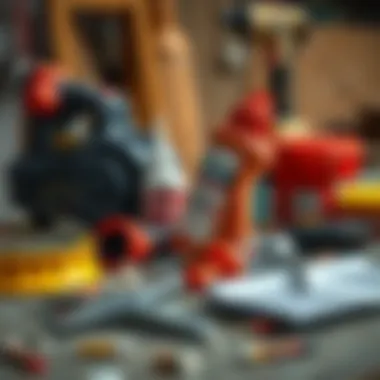
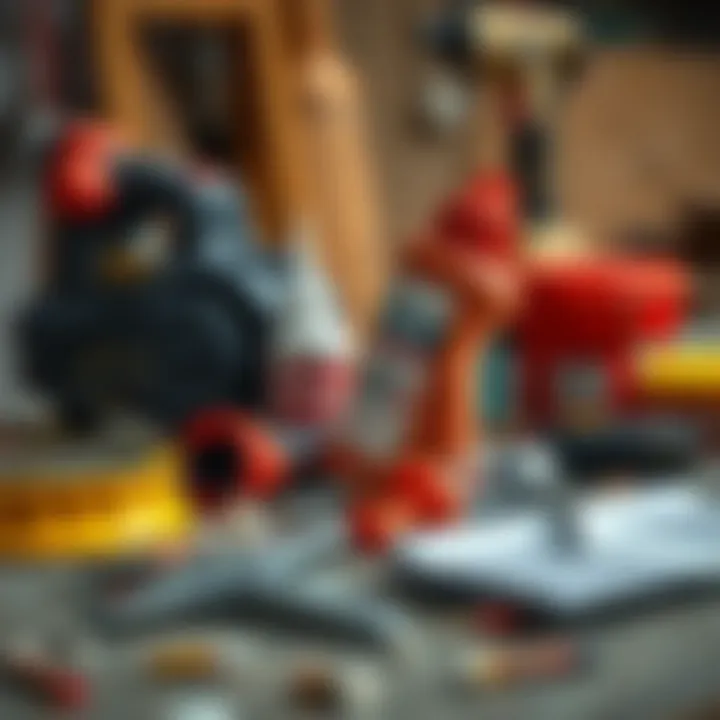
Understanding the curing times and the environmental conditions that affect the curing process is invaluable. Here’s what to keep in mind:
- Follow Manufacturer's Instructions: Each adhesive comes with specific curing time recommendations. Some may set in minutes, while others can play coy for hours, or even days. Stick to the given time to achieve optimal results.
- Temperature Matters: Most adhesives perform best at room temperature. If it’s too cold, the curing process can slow, while excessive heat can make it too tacky to set correctly.
- Humidity Effects: High humidity might complicate curing for some adhesives. It can either slow down the process or create weak bonds if moisture gets trapped in the adhesive.
- Do Not Rush: Even after initial curing, allow for the suggested full cure time before using or putting stress on the bonded area.
By understanding these conditions, rock and fossil collectors can avoid common pitfalls and ensure their projects are robust and enduring.
Proper application methods are just as important as selecting the right adhesive in achieving durable bonds in stone applications.
In summary, mastering application methods is essential for anyone working with stone adhesives. From preparing surfaces to understanding techniques and curing conditions, every step matters. Attention to detail in this process will lead to successful outcomes in projects requiring adhesive bonds.
Troubleshooting Common Issues
In the world of gluing stone, issues can arise unexpectedly, potentially jeopardizing your projects. Troubleshooting common problems is not just about fixing errors; it's also about understanding how these mishaps occur in the first place. By grasping the fundamentals of adhesive application, one can significantly reduce the likelihood of facing troubles.
Greater awareness of these issues ensures a smoother project experience and can save both time and resources. This section will delve into three prevalent challenges: misalignment, insufficient bonding, and surface contamination.
Handling Misalignment
Misalignment can be an unsettling dilemma. Imagine putting together a beautiful stone sculpture, yet the pieces refuse to fit just right. The eyesore of an off-center bond can turn even the best-crafted projects into a mess. Handling misalignment begins with awareness of how that disarray occurs. A common pitfall is not applying sufficient pressure during the curing process, leading to shifted orientations. Understanding this allows you to preemptively mitigate misalignment with careful planning and construction.
To counteract mishaps:
- Pre-assembly: Lay out your components before applying adhesive. This can help visualize the final structure and allow for any adjustments.
- Use alignment tools: Employing clamps or jigs can help keep pieces in place until the adhesive sets, ensuring they stay aligned.
- Securely support structures: Ensure your project has adequate support that accounts for gravity – especially for vertical or cantilevered designs.
Dealing with Insufficient Bonding
A lack of bonding can be frustrating; there's nothing quite like coming back to a project only to find that the pieces have come apart. Insufficient bonding can stem from various factors such as improper surface preparation or the selection of an inadequate adhesive for the job. Each adhesive has a specific set of conditions where it excels, and ignoring these can lead to a less-than-stellar outcome.
To improve bonding conditions, consider the following:
- Clean surfaces thoroughly: Remove dust, oils, and any residues from the stone surface prior to application. This is crucial for a strong bond.
- Choose the right adhesive: Different types of stone may require specific adhesives. Refer back to the types of glue section for guidance on this selection.
- Allow proper curing time: Adhesives require time to fully bond. Be patient and avoid moving the project until fully cured.
Resolving Surface Contamination
Surface contamination can sneak up on any project like a thief in the night. Oils, dust, or moisture can ruin the perfect particles needed for that coveted adhesive synergy. Identifying contamination is critical; otherwise, your hard work could go bust. This issue often exhibits symptoms through poor adhesion or hazy appearance on the surface when set.
To resolve this complication, follow these steps:
- Inspection: Examine the surfaces prior to application. If you notice any impurities, raise the alarm.
- Appropriate cleaning methods: Use water-based solvents or specific cleaning agents compatible with the stone type to scrub away contaminants.
- Test small areas: Before fully committing, perform a bonding test on a small section to gauge if additional cleaning might be necessary.
By being mindful of these common issues, one can navigate through the often choppy waters of stone gluing. With knowledge and proactive strategies, you'll transform potential setbacks into milestones on the path to creating stone masterpieces.
Safety Considerations
Selecting and using adhesives for stone projects necessitates a keen awareness of safety considerations. This aspect is not merely an afterthought; it forms the backbone of a responsible approach to working with materials that can pose risks if mishandled. Safety safeguards are essential to protect both the user and the environment. Equipping oneself with knowledge about these safeguards creates a smoother and more enjoyable working experience, significantly reducing the chances of accidents.
Safety considerations can
- help avoid health hazards, which might arise from inhaling fumes off harmful chemicals, or from skin contact with irritants.
- lead to better handling and storage of materials, ensuring you have a workspace free from accidents.
- provide guidelines on proper disposal of remnants, minimizing negative environmental impacts.
With that in mind, it’s crucial to delve into the details of safety measures, starting with an understanding of Material Safety Data Sheets (MSDS).
Understanding Material Safety Data Sheets
Material Safety Data Sheets serve as a key resource when working with adhesives or any chemicals, including those special to stone bonding. Often required by law, the MSDS provides crucial data about the chemical products one might be working with.
These sheets typically include:
- Chemical Properties: Basic information on composition, risks, and handling procedures. Knowing what you're dealing with is half the battle.
- Health Hazards: Information about potential health effects, detailing exposure routes such as inhalation, skin contact, or ingestion.
- Emergency Procedures: Guidance on what to do in case of an accident, from skin exposure to accidental inhalation.
By mastering these documents, you ensure that you’re not caught out in the wild without a map. Properly consulting an MSDS can make the difference between a minor mishap and a serious incident.
Protective Gear Recommendations
When handling glues for stone, donning appropriate protective gear is non-negotiable. It's akin to gearing up before heading out on a rocky hike; you're preparing for the uncertainties that lie ahead.
Here’s a list of essential gear to consider:
- Protective Gloves: Rubber or nitrile gloves act as barriers against chemical irritation. Avoiding direct skin contact is paramount.
- Safety Goggles: Protecting your eyes is crucial since adhesives often emit strong vapors. Safety goggles can prevent accidental splashes that could injure the eyes.
- Dust Masks or Respirators: Certain adhesives can release fumes and dust during application. Wearing a mask mitigates respiratory hazards associated with inhaling these substances.
- Aprons or Lab Coats: These help in protecting clothing and skin from spills. After all, that favorite shirt doesn't need to be the canvas for your adhesive experiments!
Wearing the proper gear means taking your safety into your own hands. Small precautions can lead to significantly healthier outcomes in both your projects and personal health.
"Investing a few bucks in safety gear can save you a fortune in medical bills down the road."
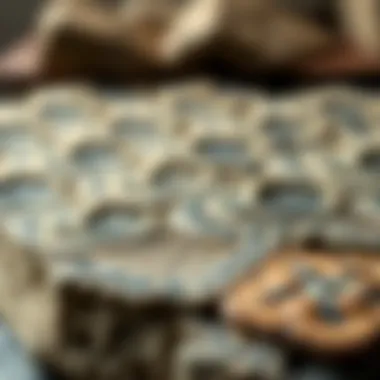
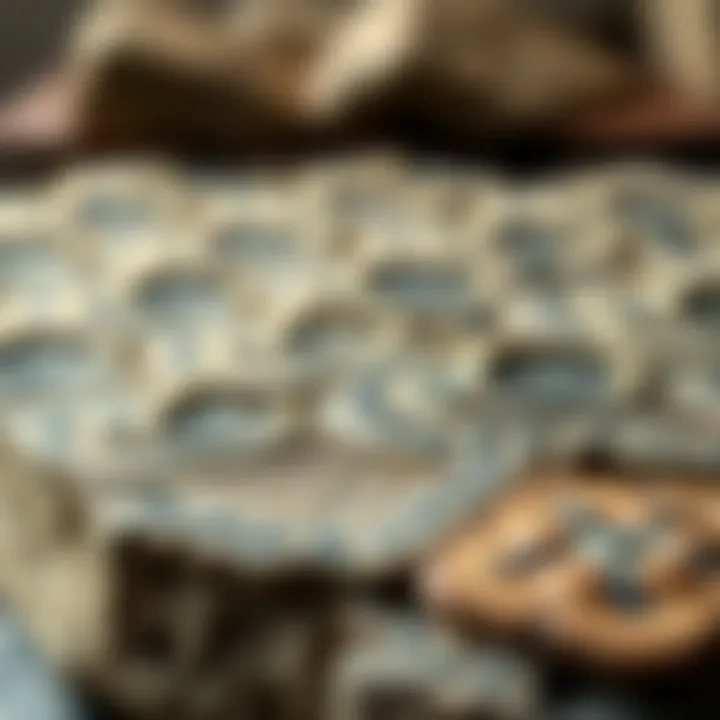
Thus, developing a safety-first mindset is not just recommended; it’s essential for anyone delving into the craft of stone bonding with adhesives.
Maintaining Bonded Stone Objects
Maintaining bonded stone objects is crucial not only for preservation but also for enhancing their longevity and aesthetic value. When stones are glued together, the integrity of the bond directly impacts the overall stability and appearance of the piece. Regular maintenance ensures that any potential issues are addressed before they develop into significant problems, which can be costly and time-consuming to fix. Additionally, the satisfaction derived from well-maintained stone objects contributes to the enjoyment and appreciation among collectors, artists, and restorers.
Cleaning Techniques for Preserved Adhesives
Cleaning is perhaps one of the most fundamental aspects of maintaining bonded stone objects. When it comes to cleaning techniques, a gentle yet effective approach is essential. Overly abrasive methods can damage the stone or the adhesive itself, leading to weakening bonds. Here are some recommended techniques:
- Soft Brush: Using a soft-bristled brush can help remove dust and debris from the surface without scratching or damaging either the adhesive or stone.
- Mild Soap Solution: A mixture of mild soap and water works wonders. Dampen a cloth with this solution and gently wipe the stone. Be sure to rinse afterwards with clean water to eliminate any soap residue.
- Isopropyl Alcohol: For tougher grime, a light application of isopropyl alcohol on a microfiber cloth can assist in lifting stains without harming the adhesive.
"Consistency is key; frequent light cleaning is far better than occasional heavy scrubbing."
- Avoid Harsh Chemicals: It cannot be stressed enough that strong acids or alkalis should be avoided as they can deteriorate the adhesive bond and cause discoloration.
Long-term Care Strategies
Long-term care strategies play a vital role in the preservation of bonded stone. These practices encompass a range of actions that seek to prevent damage and maintain the structural integrity of the bond:
- Stable Environment: Store or display bonded stone objects in a stable environment where temperature and humidity levels remain constant. Extreme fluctuations can lead to moisture issues, affecting both the stone and the adhesive.
- Avoid Direct Sunlight: UV light can deteriorate some adhesives over time. If possible, keep bonded stone objects out of direct sunlight, employing UV-filtering glass for display cases.
- Regular Inspections: Conduct periodic checks for any signs of wear or damage. Look for chips in the stone or any areas where the adhesive may seem compromised.
- Dust Control: Keeping the surrounding area clean reduces dust buildup on the object. Less dust equates to less need for cleaning, which can be abrasive.
- Gentle Handling: When moving or adjusting bonded stone objects, handle them with care to avoid shock or stress that could weaken the bond.
In essence, maintaining bonded stone objects is about being proactive. With the right practices, you can ensure that your stone masterpieces not only look great but endure the test of time.
Case Studies of Successful Applications
The examination of case studies sheds light on the practical utilization of adhesives for stone, showcasing real-world implementations and their outcomes. This section delves into the intricate details of how various adhesives are actively applied in art installations and structural repairs, emphasizing the multifaceted benefits and considerations that come into play. These examples not only serve as a guide for enthusiasts but also demonstrate the effectiveness of suitable glue choices in the real world and inform future selections.
Art Installations
Art installations present a unique challenge when working with stone due to the demanding aesthetic and durability requirements. Various artists have used adhesives skillfully to not only bond materials but also to enrich their creative stories.
A notable example is the large-scale sculpture by artist Andy Goldsworthy, which intricately bonds stones of differing shapes and colors using specific epoxy adhesives. This method not only ensures the structural integrity of the installation but also complements the organic essence of the materials used.
Key aspects to consider when selecting glue for art installations include:
- Durability: The adhesive must endure the elements, especially for outdoor pieces that face weather changes.
- Aesthetic Quality: Transparency or color matching can significantly affect the final appearance. Some glues can dry clear, thus minimizing visual impact.
- Workability: Depending on the project, certain adhesives allow for longer application times, which is crucial for detailed artistic work.
Artists, when integrating glue in their pieces, often test various adhesive types to find the perfect match. For instance, one artist highlighted that using polyurethane adhesives resulted in a more flexible bond, catering to the dynamic aspects of their moving art.
"The harmony of materials is enhanced by a glue that complements rather than overshadows the stone," remarked a sculptor on the relationship between artistry and adhesive selection.
Structural Repairs
When it comes to structural repairs, the stakes are considerably higher. The adhesive choice can ascertain not just aesthetic appeal but also the lifespan and functionality of the structure. Properly bonding stones in a structurally sound manner is vital, as is the approach taken.
Consider the restoration of a stone archway in an historical building that required careful attention to detail. Contractors utilized a hybrid of epoxy and silicone adhesives to address both compressive strength and sealing against moisture, proving essential in preserving the integrity of the structure.
Factors that guide adhesive selection for structural repairs include:
- Load-Bearing Capacity: The adhesive must support the weight of the stone elements effectively, particularly in archways or large installations.
- Resistance to Environmental Factors: Exposure to moisture, temperature fluctuations, and UV rays can degrade some adhesives more quickly than others.
- Ease of Application: The ability to work efficiently without compromising safety or effectiveness is critical in tight spaces or complex repairs.
For those undertaking repairs, a thorough understanding of the chemistry involved can lead to informed decisions. Identifying the right adhesive not only preserves the structure but also ensures that the repairs last decades, if not centuries.
The choice of adhesive in both art and structure highlights the importance of balancing function with creativity, reinforcing the integral role that adhesives play in successfully executing stone projects.
Future Trends in Stone Adhesives
The world of adhesives for stone is constantly evolving, driven by a need for better performance, sustainability, and application versatility. Future trends in stone adhesives will not only shape how restorers and architects approach their projects but also influence the materials that will define our built environment for years to come. This section will dissect advancements in formulation technology and delve into crucial environmental considerations, ultimately guiding rock and fossil collectors as they navigate the landscape of stone adhesion.
Advancements in Formulation Technology
Recent years have seen significant strides in the formulation of adhesives designed for stone. Manufacturers are moving away from traditional formulations, replacing them with innovative blends that boast improved bonding capabilities and reduced curing times. One of the key advancements is in the use of smart adhesives, which can adapt to various environmental conditions. For example, some formulations now include temperature-sensitive ingredients that enhance their performance based on ambient conditions, allowing for effective bonding even in fluctuating temperatures.
Additionally, there's an increasing focus on bio-based adhesives. These utilize renewable resources, providing a sustainable alternative to synthetic options, which is particularly appealing in light of growing environmental awareness. Such advancements not only support the bond strength required for heavy stone materials but also cater to those who wish to minimize their ecological footprint.
Moreover, with the integration of nanotechnology, manufacturers are developing adhesives that harness microscopic particles to reinforce bond strength. This results in adhesives that can stand the test of time and deliver exceptional resistance to environmental factors that typically weaken connections.
"The landscape of adhesive technology is transforming rapidly, where innovation meets sustainability, benefiting both the user and the environment."
Environmental Impact Considerations
As awareness grows regarding the environmental footprint of construction materials, stone adhesives are under scrutiny for their ecological implications. Today's consumers are not solely focused on performance; they are also interested in the long-term sustainability of the materials they choose. The adhesive industry is responding by researching and developing products that have a lower environmental impact.
One of the shifts is the commitment to reducing volatile organic compounds (VOCs) in adhesives. High VOC levels can contribute to air pollution and have adverse health effects. New formulations aim to minimize these chemicals while still offering excellent adhesion properties. Further, manufacturers are seeking certifications that endorse their products as environmentally friendly, which can make a significant difference in consumer choices.
Another trend is the promotion of recyclability in adhesives. Traditional adhesives may bind stone permanently, often complicating recycling efforts. Emerging adhesives are being designed with dismantling in mind, allowing for easier separation of materials without damaging the stones.
As environmental regulations become more stringent, companies will have to balance performance with adherence to new guidelines. Staying informed and choosing adhesives that not only perform well but also align with environmental values will be crucial for rock and fossil collectors looking to maintain their collections responsibly.



